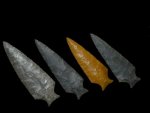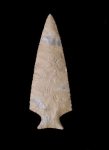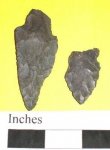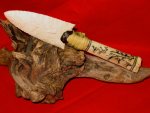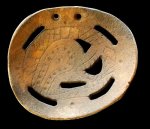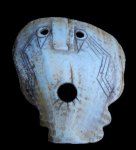Most of you know me by now due to my mammoth painting skills in the wet shaving world. Many of you may not know that I'm also a flintknapper with 17 years experience. Flintknapping in a nutshell is creating knife blades, arrow & dart tips, and spear tips using flints and cherts just like our ancient relatives used to do. I find flintknapping is the great equalizer in society because no matter who you are or where you came from or what you believe, your relatives survived using flint tools at some point in the past. I've done a fair amount of work for museums and private collectors, but I also attend several shows each year where I sell my creations to sustain the hobby.
In 2016 I also started my venture into blacksmithing. It's been quite a journey starting with a little 70 lb poor quality anvil I borrowed from my dad to where I am today having my 179 lb German Trenton anvil dating from the 1890's and my other 160 lb Fisher anvil dating 1906. I've been working steadily at building a wide variety of blacksmithing skills doing hooks, hinges, and all manner of useful hardware. 2018 saw me making my first knife blade and it is my intention to become a well rounded blacksmith able to do just about anything with a hot piece of metal. 2019 I officially named my forge "Yorkshire Forge" and had stamps made so that I can mark my metal work with my forge name. The village I live in used to be called Yorkshire in the 1700's and 1800's which makes me just the 4th blacksmith to have a smithy in this area since it got settled. I've set up a nice little smithy and look forward to what the future holds.
In addition to the flintknapping and blacksmithing I also do a wide variety of other historical crafts. Powder horns, pottery, arrows, sculptures, pipe tomahawks, tomahawks, fire striker sets, and even pen & ink drawings. The great thing about my hobbies is that they provide me a way to sustain them by releasing things out to better homes than mine. I'll be sharing the various things I'm working on and if anything interests you please feel free to post about it and send me a personal message for anything that would constitute a business transaction or special order.
In 2016 I also started my venture into blacksmithing. It's been quite a journey starting with a little 70 lb poor quality anvil I borrowed from my dad to where I am today having my 179 lb German Trenton anvil dating from the 1890's and my other 160 lb Fisher anvil dating 1906. I've been working steadily at building a wide variety of blacksmithing skills doing hooks, hinges, and all manner of useful hardware. 2018 saw me making my first knife blade and it is my intention to become a well rounded blacksmith able to do just about anything with a hot piece of metal. 2019 I officially named my forge "Yorkshire Forge" and had stamps made so that I can mark my metal work with my forge name. The village I live in used to be called Yorkshire in the 1700's and 1800's which makes me just the 4th blacksmith to have a smithy in this area since it got settled. I've set up a nice little smithy and look forward to what the future holds.
In addition to the flintknapping and blacksmithing I also do a wide variety of other historical crafts. Powder horns, pottery, arrows, sculptures, pipe tomahawks, tomahawks, fire striker sets, and even pen & ink drawings. The great thing about my hobbies is that they provide me a way to sustain them by releasing things out to better homes than mine. I'll be sharing the various things I'm working on and if anything interests you please feel free to post about it and send me a personal message for anything that would constitute a business transaction or special order.

